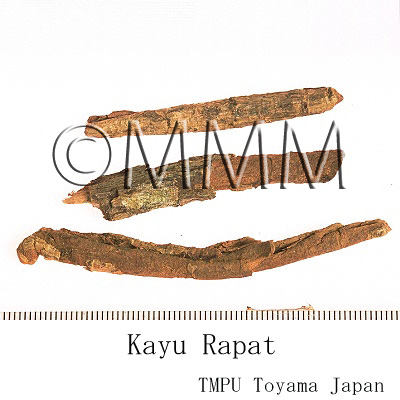Crude drug sample data base
※Click on the image to enlarge it.
The capital city, provincial capital city or the representative
location of its administrative area is indicated.
location of its administrative area is indicated.
-7.0051453
110.43812539999999
Production area information
Republic of Indonesia,Central Java Province
https://ethmed.toyama-wakan.net/img/pin_san.png
-7.2574719
112.75208829999997
Collection information
Republic of Indonesia,East Java Province
https://ethmed.toyama-wakan.net/img/pin_nyu.png
Scientific information data base
| Crude drug name | Indonesian name, English name | Kayu rapet | ||||
|---|---|---|---|---|---|---|
| crude drug image |
| |||||
| Original plant name | Parameria laevigata (Juss.) Moldenke | |||||
| Family name | Apocynaceae | |||||
| Used part | Bark | |||||
| Distribution area | It is found in India, southern China, Burma, Indo-China, Thailand, Peninsular Malaysia, Singapore. It grows wild in Sumatera, Java, Sulawesi, Borneo and other Indonesian Islands in primary and secondary forests and thickets from sea-level up to 1500 m altitude [201, 220]. | |||||
| Description | The bark is rough and if broken, strands of latex exuded when a piece of bark is broken will contract so as to make the wound invisible afterwards. The plant is a perennial climber up to 10 m long, branches often lenticellate, leaves opposite, simple, elliptical to obovate, base obtuse to cuneate, apex to caudate, blade pappery. Inflorescence a terminal panicle or shorter cymes scatterd along the stem, many-flowered, white. Fruit a paired follicle, distantly tortulose, glabrous, 4-10 seeds. Seed elliptical, brown [220]. Odour - soft, taste - astringent; slightly bitter. | |||||
| Drug effect | Cooling, astringent [201, 231]. | |||||
| Specific actions | Stomachic, disinfectants, astringent [201, 231]. | |||||
| Frequency in use | Moderate | |||||
| Common uses | Commonly it is used among Javanese and Balinese women upon approaching their wedding day [220]. | |||||
| Pharmacological effect | Antimicrobial activity: ethanol (80%), n-hexane,chloroform extracts of the bark inhibited the growth in vitro of Escherichia coli. An aqueous extract of the leaves showed partial inhibition of the bacteria Micrococcus aureus and Escherichia coli [220]. | |||||
| Medical system | Indonesian medicine (Jamu) | |||||
| Traditional usage | A decoction or a wash made of the bark is used after childbirth to make the uterus shrink. It is used to heal wounds, dysentery, scabies, tuberculosis and as an astringent. In Java and Bali the latex is used to heal wounds. Balinese made paste from the bark for treating dysentery, it has cooling and astringent properties [201, 220]. | |||||
| Formulation | 1) After childbirth to make the uterus shrink: 15 g of bark is boiled with 3 glasses of water for 25 minutes, let stand to cool and strain. Drink the decoction twice a day every morning and evening [207]. 2) Galian rapet for the restoration of general well-beings after childbirth and slimming: Cortex Parameriae (20%), Cortex Granati Fructus (15%), Fructus Coriandri (7.5%), Semen Colae (2%). Doses: 2 capsuls twice a day 3 times a week. 3) Body slim for tummy firming: Folium Guazumae (20%), Rhizoma Curcumae Domesticate (15%), Lignum Sappan (10%), Cortex Parameriae (15%). Dose: 1-2 capsul three times per day on a regular basis. | |||||
| References | Reference book Tips! | [201] K. Heyne, Tumbuhan Berguna Indonesia, Vols. 1-4, 1987. Diedarkan Oleh Koperasi Karyawan Departemen Kehutanan, Jakarta, Indonesia. Vol. 3 p 1642. [203] Departemen Kesehatan Republik Indonesia, Materia Medika Indonesia, Vol. 1 (1977), Vol. 2 (1978), Vol. 3 (1979). Vol. 4 (1980), Vol. 5 (1989), Vol. 6 (1995), Jakarta, Indonesia. Vol. 1, p 63. [207] Badan Penelitian Dan Pengembangan Kesehatan and Departemen Kesehatan, Kesejahteraan Sosial Ri. Vols. 1-5, Inventaris Tanaman Obat Indonesia, Jakarta, Indonesia. Vol. 3, p 1837. [220] van Valkenburg, J.L.C.H. and Bunyapraphatsara, N. (editors). Plant Resources of South-East Asia No. 12 (2). Medicinal and posionous plants 2. Prosea Foundation, Bogor, Indonesia, 2002. pp 402-403. [222] P.T. Eisai Indonesia: Medical Herb Index in Indonesia (Second edition).1995. p 198. [223] UPT Balai Pengembangan Kebun Raya Lembaga Ilmu Pengetahunan Indonesia: Koleksi tumbuhan obat Kebun Raya Bogor (Collection of medicinal plants in Bogor Botanical Garden). 1999. p 42. [231] Soedibyo, Mooryati: Alam Sumber Kesehatan: Manfaat dan Kegunaan (Natural resources for health. Benefits and uses). Balai Pustaka. 1998. pp 197-198. | ||||
| Remarks | When dried bark is broken into pieces, latex appeared in the form of fine thread which seemed to hold the pieces into one [220]. The bark is one of the popular ingredients in many jamu products under the name ''Sari Rapet'' which is usually used to keep female sexual organ in a good condition. | |||||
| Last renewal date | 2024/03/15 | |||||







